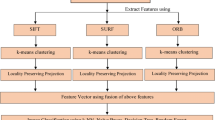Abstract
Local descriptors play a crucial role in numerous computer vision and pattern recognition applications. This paper proposes a novel local descriptor, called the quaternionic local angular binary pattern (QLABP), for color image classification. QLABP is based on the quaternionic representation (QR) of color images such that it is able to handle all color components holistically as well as consider their relations. Using QR, the quaternionic angular information is further developed to account for more color characteristics. We provide two ways to derive the quaternionic angular information from different perspectives. A pattern encoding operation is finally conducted on the obtained angular information to obtain QLABP. The effectiveness of QLABP has successfully been evaluated by comparing with several state-of-the-art descriptors.



Similar content being viewed by others
Notes
Note that there are two types of CT for a quaternion, namely the left CT and right CT, and their phases are equal. We use the right CT as in Eq. (7) to illustrate the derivation of QLABP in this paper.
References
Backes AR, Casanova D, Bruno OM (2012) Color texture analysis based on fractal descriptors. Pattern Recognit 45(5):1984–1992
Bianconi F, Fernández A, González E et al (2009) Rotation-invariant colour texture classification through multilayer CCR. Pattern Recognit Lett 30(8):765–773
Campana L, Keogh J (2010) A compression-based distance measure for texture. Stat Anal Data Min ASA Data Sci J 3(6):381–398
Chen J, Shan S, He C et al (2010) WLD: a robust local image descriptor. IEEE Trans Pattern Anal Mach Intell 32(9):1705–1720
Chhabra P, Garg NK, Kumar M (2018) Content-based image retrieval system using ORB and SIFT features. Neural Comput Appl. https://doi.org/10.1007/s00521-018-3677-9
Ell T (1992) Hypercomplex spectral transforms. PhD dissertation, University of Minnesota, Minneapolis
Ell T, Sangwine S (2007) Hypercomplex Fourier transforms of color images. IEEE Trans Image Process 16(1):22–35
Gai S, Wan MH, Wang L, Yang CH (2014) Reduced quaternion matrix for color texture classification. Neural Comput Appl 25(3–4):945–954
Gao L, Guo Z, Zhang H, Xu X, Shen HT (2017) Video captioning with attention-based lstm and semantic consistency. IEEE Trans Multimed 19(9):2045–2055
Geng T, Yang M, You Z, Cai Y, Huang F (2018) Multiscale overlapping blocks binarized statistical image features descriptor with flip-free distance for face verification in the wild. Neural Comput Appl 30(10):3243–3252
Guha T, Ward RK (2014) Image similarity using sparse representation and compression distance. IEEE Trans Multimed 16(4):980–987
Guo Z, Zhang L, Zhang D (2010) A completed modeling of local binary pattern operator for texture classification. IEEE Trans Image Process 19(6):1657–1663
Hamilton WR, Hamilton WE (1866) Elements of quaternions. Longmans, Green, & Company, London
Hoang MA, Geusebroek JM, Smeulders AWM (2005) Color texture measurement and segmentation. Signal Process 85(2):265–275
http://www.nada.kth.se/cvap/databases/kth-tips/. Accessed 1 Oct 2014
Junior J, Cortez C, Backes R (2014) Color texture classification using shortest paths in graphs. IEEE Trans Image Process 23(9):3751–3761
Lan R, Zhou Y (2016) Quaternion-Michelson descriptor for color image classification. IEEE Trans Image Process 25(11):5281–5292
Lan R, Zhou Y, Tang YY (2016) Quaternionic local ranking binary pattern: a local descriptor of color images. IEEE Trans Image Process 25(2):566–579
Lan R, Zhou Y, Tang YY (2017) Quaternionic weber local descriptor of color images. IEEE Trans Circuits Syst Video Technol 27(2):261–274
Lan R, Zhou Y, Tang YY, Chen CLP (2014) Person reidentification using quaternionic local binary pattern. In: IEEE international conference on multimedia and expo (ICME), pp 1–6
Lee SH, Choi JY, Ro YM, Plataniotis KN (2012) Local color vector binary patterns from multichannel face images for face recognition. IEEE Trans Image Process 21(4):2347–2353
Liu G, Li Z, Zhang L, Xu Y (2011) Image retrieval based on micro-structure descriptor. Pattern Recognit 44(9):2123–2133
Lu H, Li B, Zhu J, Li Y, Li Y, Xu X, He L, Li X, Li J, Serikawa S (2017) Wound intensity correction and segmentation with convolutional neural networks. Concurr Comput Pract Exp 29(6):e3927
Lu H, Li Y, Uemura T, Ge Z, Xu X, He L, Serikawa S, Kim H (2017) Fdcnet: filtering deep convolutional network for marine organism classification. Multimed Tools Appl 77(17):21847–21860
Nguyen D, Zong Z, Ogunbona P, Li W (2010) Object detection using non-redundant local binary patterns. In: 17th IEEE international conference on image processing (ICIP), pp 4609–4612
Ojala T, Pietikainen M, Maenpaa T (2002) Multiresolution gray-scale and rotation invariant texture classification with local binary patterns. IEEE Trans Pattern Anal Mach Intell 24(7):971–987
Paschos G, Petrou M (2003) Histogram ratio features for color texture classification. Pattern Recognit Lett 24(1):309–314
Porebski A, Vandenbroucke N, Macaire L (2008) Haralick feature extraction from LBP images for color texture classification. In: First workshops on image processing theory, tools and applications, pp 1–8
Satpathy A, Jiang X, Eng H (2014) LBP based edge-texture features for object recognition. IEEE Trans Image Process 23(5):1953–1963
Swain MJ, Ballard DH (1991) Color indexing. Int J Comput Vis 7(1):11–32
Tan X, Triggs B (2010) Enhanced local texture feature sets for face recognition under difficult lighting conditions. IEEE Trans Image Process 19(6):1635–1650
Wang D, Lu H, Li X (2011) Two dimensional principal components of natural images and its application. Neurocomputing 74(17):2745–2753
Wang D, Lu H, Yang MH (2015) Kernel collaborative face recognition. Pattern Recognit 48(10):3025–3037
Weeks J, Lehoucq R, Uzan JP (2003) Detecting topology in a nearly flat spherical universe. Class Quantum Gravity 20(8):1529
Xu X, He L, Lu H, Gao L, Ji Y (2018) Deep adversarial metric learning for cross-modal retrieval. World Wide Web. https://doi.org/10.1007/s11280-018-0541-x
Xu X, He L, Shimada A, Taniguchi R, Lu H (2016) Learning unified binary codes for cross-modal retrieval via latent semantic hashing. Neurocomputing 213:191–203
Xu X, Shen F, Yang Y, Shen HT, Li X (2017) Learning discriminative binary codes for large-scale cross-modal retrieval. IEEE Trans Image Process 26(5):2494–2507
Yang M, Qian YQ, Xue LJ, Li H, Deng LY, Wang CX (2018) G2P: a new descriptor for pedestrian detection. Neural Comput Appl. https://doi.org/10.1007/s00521-018-3815-4
Acknowledgements
This work was partially supported by the National Natural Science Foundation of China (Nos. 61702129, 61772149, U1701267, and 61320106008), China Postdoctoral Science Foundation (No. 2018M633047), Guangxi Science and Technology Project (No. 2018AD19029), the Macau Science and Technology Development Fund under Grant FDCT/189/2017/A3, and by the Research Committee at University of Macau under Grants MYRG2016-00123-FST and MYRG2018-00136-FST.
Author information
Authors and Affiliations
Corresponding author
Ethics declarations
Conflict of interest
The authors declare that they have no conflict of interest.
Additional information
Publisher's Note
Springer Nature remains neutral with regard to jurisdictional claims in published maps and institutional affiliations.
Rights and permissions
About this article
Cite this article
Lan, R., Lu, H., Zhou, Y. et al. An LBP encoding scheme jointly using quaternionic representation and angular information. Neural Comput & Applic 32, 4317–4323 (2020). https://doi.org/10.1007/s00521-018-03968-y
Received:
Accepted:
Published:
Issue Date:
DOI: https://doi.org/10.1007/s00521-018-03968-y




